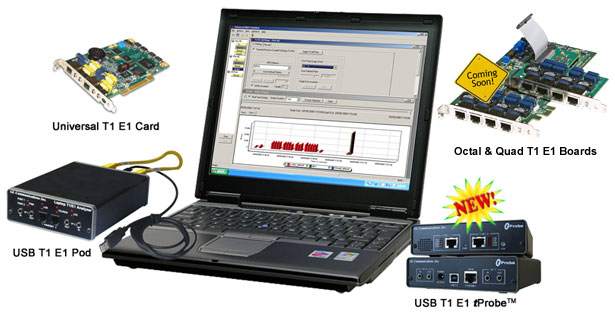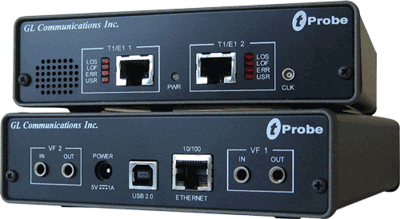GL Enhances T1 E1 Analyzer Products & Software
Welcome to the February issue of GL's Newsletter covering new applications, new hardware, and enhancements to our versatile T1 E1 Analyzer product line. The Ennhanced T1 E1 software, and hardware are now part of Version 6.0.

New Hardware Introduction
tProbe™ T1 E1 Analyzer Unit (USB Based)

The future of T1 E1 VF Data Analysis / Emulation
GL's new tProbe™ is an enhanced version of our popular USB based T1 E1 VF Analyzer. The tProbe™ incorporates all the same features of the previous analyzer such as portability, USB interface, remote accessibility, scripting, and a vast set of optional applications. tProbe™ comes with "basic software" for basic testing needs and optional features that extend the capability far beyond the most expensive T1 E1 testers. In addition, the tProbe™ has the following very important enhancements:
- Pulse Mask and Jitter Measurement Hardware and Software
- "Cross-port Through" Mode and "Cross-port Transmit" Mode options make cabling with Drop/Insert and Fail-Safe Inline Monitoring very easy
- Enhanced VF Drop and VF Insert Capabilities (including 3.5mm or Bantam physical connection options)
- Improved circuitry for very accurate Digital Line Level measurements
- Forward thinking hardware design for future daughter board expansion applications
- Includes clock slip registers, clock timer
- Software selectable T1 E1 interface along with Drop and Insert
- Switchable Line Level or Microphone input using 3.5 mm or Bantam physical connectors
- VF Tx Gains ranges from -12 dB to +59.5 dB in 0.5 dB steps, and VF Rx Gains from -63.5 dB to +9 dB in 0.5 dB steps
- tProbe™ analyzer has speaker output for Tx & Rx directions for each port
- The VF Tx and Rx impedances for tProbe™ analyzer supports software selectable 135, 150, 600, or 900 Ohm terminations, New High Impedance Monitor Termination (>25K Ohms), and Mic/HS impedance (Microphone Headset impedance is 1K Ohms)
New Software Applications
New applications introduced into T1 E1 Analyzer Version 6.0 are described briefly below:
- ATM BERT
ATM Bit Error Rate Test (BERT) application permits BER testing over ATM layer. It allows an ATM virtual circuit to be tested by sourcing test traffic and verifying at the receive end. Other features are: Bit Error Insertion, Looping back incoming traffic (using T1 E1 Loopback), and configuring ATM headers for UNI & NNI interfaces. The application is capable of testing Pseudo Random Bit Sequence (PRBS) patterns, all ones, all zeroes, alternate ones & zeroes, 1:1, 1:7, and user-defined bit patterns. In addition, single bit error insertion, auto error insert rate from 10-2 to 10-9, invert & non-invert selections, and scrambling options (according to ITU-T G.804) are provided.
- Simplified Audio Client (SAC)
GL's tProbe™ T1 / VF Analyzer unit supports a Simplified Audio (VF) Client (SAC) application to perform non-intrusive and intrusive VF monitoring, VF recording, and VF testing. SAC provides an alternate & simple GUI to perform analog Tx/Rx functions.
- WCS - Client Data Tx Rx
Client Data Tx Rx is an optional WCS Server side module that provides the capability for "clients" to Tx Rx T1 E1 data to and from the Server. Previously one could only Tx & Rx files from the server location but not the Client location (in the case that the Server and Client are not the same PC). Now the client can transmit and receive files or T1 E1 data directly to and from the server. Its main functions are:
- receives raw data from T1 E1 line and sends it to the client as task data messages
- receives data from the client via task data messages and transmits this data on T1 E1
- ASCII- TS Display Application
This application permits viewing of real-time ASCII events that are present on the T1 or E1. The ability to display the ASCII events for a particular port and timeslot is provided. Each event is properly time-stamped for tests that require time correlation. Logging real-time events to the hard drive is also possible.
Enhancements Introduced to the Existing Applications
- Jitter Measurement & Pulse Mask
Implemented Rx Line Frequency and Frequency Offset - MAPS
The enhancements introduced to the application are as below: - Load Generation is added to generate Bulk Calling Capability providing CPS or BHCA, Max Simultaneous Calls and Burst parameters
- Statistics feature indicates Total, Active, Completed, Passed and Failed Call counters including a Pie graph to indicate Pass/Fail Call Ratio
- Statistics Options allows grouping set of scripts with particular names. When these scripts are run, counters in Statistics Dialog get updated
- Link Status features indicates Transport related information of the Protocol. It is enabled for SS7 and GSM A
- Event Config Dialog tab is added for editing event profiles at the runtime
- Passing user parameter (variable values) to 'user event' at the run time using event profiles in Event Config window
- New script flow tab added in Call Generation & Reception windows
- Supports Master Configuration option
- Changes in the appearance of the xml related files i.e. Test-bed Setup Profile, Profiles, Event Profiles
- New instructions such as message handler, start timer, stop timer, return, initialize unique id, allocate unique id, reserve unique id, and free unique id are added
- Existing instructions such as 'wait' (i.e. wait for Infinite time is added); 'ActiveUserEvent' (i.e. adding and removing labels) and 'StopRetxmit' (i.e. Stop Variable is removed) are modified
- Ability to add & remove "Call Handlers" from GUI
- MTP2 state log messages
- Protocol Analyzer
The enhancements introduced to the Protocol Analyzer applications are: - SS7 Protocol Analyzer: Prevent Cyclic Retransmission in SS7 Protocol for Satellite and Slow Intercontinental Links
- MLPPP Protocol Analyzer:
- Added new standard (PPP SigTran) to PPP analyzer and removed CiscoHDLC standard
- New INI file option has been added to read the configured IP layer offset.
- Option to select UDP checksum presence/absence in the compressed UDP packet (IPHC compressed non-tcp packet)
- PPP Mux decode has been updated to decode more protocol field values.
- "PPP Mux CP" protocol field display for the Protocol-Reject message
- "VJ Uncompressed TCP" protocol field display for the PPP Multiplexed sub frame
- Sample trace files have been added for PPP-VoIP PDA
- Windows Client-Server (WCS)
The enhancements introduced to the application are as below: - G.729 implementation - The codec has been implemented as a DSP operation.
- Crossport, VF I/O, Impedance command changes - Includes new set of commands to set loopback modes, VF I/O, and VF Impedances in tProbe™, and Universal cards.
- GLClient - Now handles a wide variety of Text formats, including that used by notepad
- WCS MLPPP Emulator
The enhancements introduced to the application are as below: - Link configuration tab in MLPPP View has been updated to include PPP in MLPPP configuration with Protocol field compression, and Address and Control Field compression
- Action tab now includes "Traffic Mode" option, which allows users to maintain timing between frames. If the emulator is configured as router (using NETWORK TRAFFIC source and sink type) it might be required to maintain the timing while forwarding packets from Ethernet to T1 E1 and vice versa i.e. time difference between the consecutive packets captured from NIC card is maintained while transmitting on T1 E1 and vice-versa
- MLPPPterr
The enhancements introduced to the application are as below: - Accepts new command: PPP_IN_MLPPP to inform the server about the ppp header config in MLPPP
- PPP header in MLPPP can be configured by PPP_IN_MLPPP command
In addition to the above, there have been many minor modifications and bug fixes to the T1 E1 Software. For more details, please refer to the link what's new in the current version web page.
 Back to Latest News Page
Back to Latest News Page